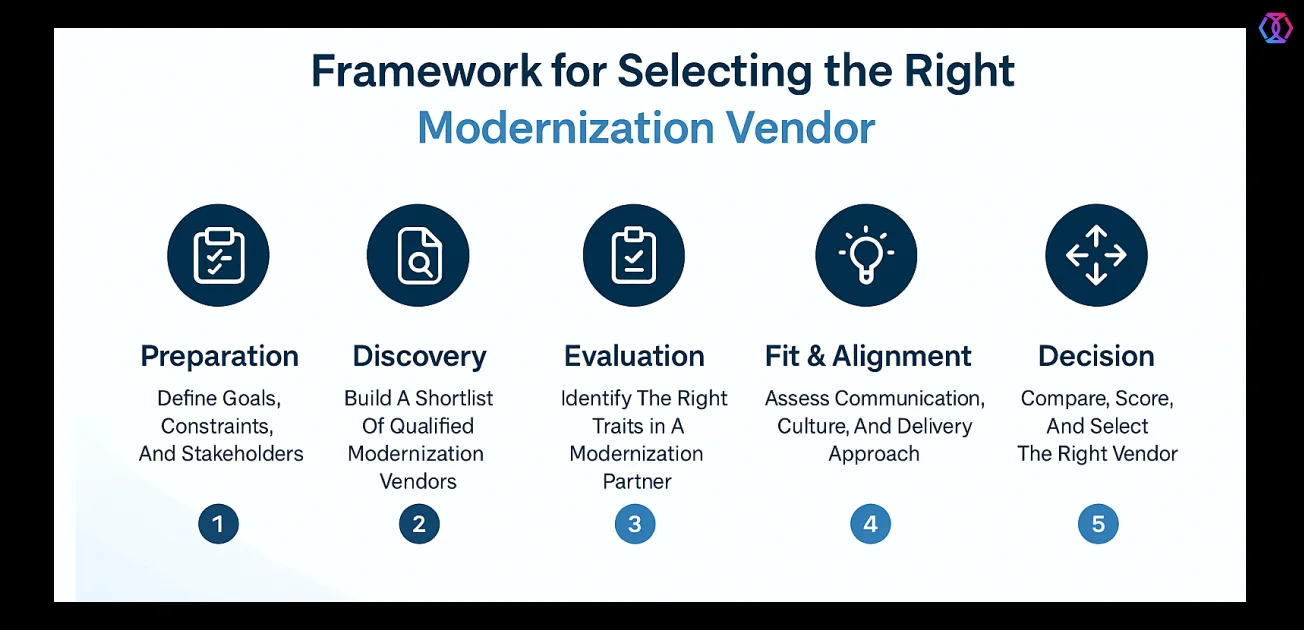Table of content
70% of legacy modernization projects fail because updating business systems involves more than just code refactoring; it requires synchronizing technology, people, and processes to achieve tangible results.
At Devox Software, we’ve helped businesses update their old systems, some of which had well over 2 million lines of code and decades of business logic. We’ve understood that success depends less on the technologies and more on finding the right partner. That’s why this material breaks down everything vital for choosing legacy modernization vendors that make a difference for your business. Let’s start.
Step 1: Set Goals, Constraints, and Stakeholders
To modernize, you need to be clear. What do you want to do? Cut down on manual work, make things more scalable, or make sure you follow the rules?
When you say something imprecise like “make it better,” it might lead to scope drift. But when you say something specific like “reduce invoice processing time by 40%,” the vendor knows exactly what you want. The latter situation makes it easier for your vendor to recommend the best way to modernize, whether that means rehosting, re-platforming, or starting from scratch.
Furthermore, not everything could be equally modernized. Every modernization project has restrictions, such as money, dependencies, old systems that are difficult to work with, and, of course, people. Such common obstacles may include:
- Budget: Put ROI-driven projects at the top of your list.
- Compliance: Include HIPAA, GDPR, or ISO 27001 from the start.
- Legacy Complexity: Mainframes and Domino programs have logic that can’t be replaced. Keep what works.
- Team: Get internal teams involved with the process to eliminate human factors.
- Stakeholders: Involve IT, operations, compliance, and internal developers. When teams know the “why,” they work together instead of against each other.
Who should be involved in the discussion?
- The CIO or IT Head sets the direction for technology.
- The COO, or Head of Operations, talks about improvements to the way things work.
- The Compliance Head points out hazards related to the legislative and regulatory norms.
- Business Unit Leads bring perspective to day-to-day work.
- Internal developers invest in the knowledge of how old systems work.
By addressing these priorities before the initial calls commence, the entire project is likely to proceed more smoothly.
To sum up this section, here is a checklist to prepare for modernization before you start to select application modernization vendors:
- What are your main goals for modernization? How do they help businesses?
- What security or regulatory norms do you need to comply with?
- Who is entitled to agree to a particular vendor and sign off on important milestones?
- How much is the budget, and where can you be flexible?
- What parts of your old system are performing well, and what parts are not?
- Who inside the company knows the most about the system?
- Are you ready to keep internal information and make it easier for people to accept?
- Have you told each stakeholder how modernization would affect them?
- Do you have a plan to involve your teams?
- Have you pointed out risks that could slow down progress?
Only if you know the answers to all the questions, let’s proceed to the second step.
Step 2: Prepare a Long List of Legacy Modernization Vendors
Before you evaluate and reach out, you need to compile a long list of legacy modernization vendors. These are the most proven ways to find them:
- Referrals: Ask coworkers or people you know in the industry for vendors they trust or have worked with.
- Specialized Platforms: Clutch, G2, and Capterra are online platforms that can help you get verifiable reviews, compare options, and see how suppliers work in real life as presented in the testimonials and case studies.
- Consultants: If you work with consulting organizations like Gartner or ISG, they can give you unbiased, research-backed shortlists based on your IT and business needs.
- Trade Shows and Conferences: You may talk to vendors in person, ask them direct questions, and see their solutions.
- Social Media: LinkedIn groups and discussion boards: Join conversations that are relevant to you to find out who is being suggested and why. Real talks show more than well-designed websites.
For an excellent result, you’d need to mix these channels or try all of them. It’s ok, since the goal is to gather as much information as possible and further verify it across multiple sources.
Step 3: Cut the List of Legacy Modernization Vendors
When you’ve compiled an extended list of vendors that might be helpful with legacy modernization, let’s choose factors according to which we need to assess them. The most effective ways are to find and review:
- Relevant Case Studies: Proof that a vendor can manage the modernization of large integrated systems.
- Industry Specifics: Do they know how to follow the rules and regulations in your field? Banking, FinTech, and manufacturing are very sensitive to industry standards. Have they worked with companies from the same sphere?
- Integration Skills: If a vendor can link CRMs, ERPs, and cloud platforms.
- AI-Assisted Modernization Tools: Companies using AI to speed up code analysis, testing, and other tasks give a competitive advantage to businesses.
- Cross-Team Collaboration: The ability to work with both IT and business departments at the same time to ensure a smooth transition.
Give priority to suppliers who have a lot of experience, good case studies, and a history of dealing with complicated, old systems. Then, rearrange the list, giving the scores for the following:
- Experience with Complex Cases: Hands-on experience with projects requiring advanced skills. That includes using mainframes, Lotus Notes, or platforms that were made just for them. Most essential, they should know how to update systems without disruption.
- Domain Knowledge: Knowing how your industry works and what rules it has to follow. They’ll know how your business works, speak your language, and keep you away from making expensive mistakes. Moreover, they will give you effective, proven solutions instead of merely trendy ones or merely experimenting.
- Financial Stability: Since complex legacy modernization timelines can span over several months, you need to find a financially reliable vendor. They should have a solid crew, room to grow, and be able to invest in their skills.
- Awareness of Compliance: Your partner should be familiar with rules like HIPAA, GDPR, and SOC 2 from the start, not learning in the process. They should know how to make secure, monitored systems that are easily passed through compliance checks.
- Excellence in Technology: Mastery of APIs, cloud-native architectures, and automation solutions tailored to your case.
- Transparent Delivery Framework: Look for discipline and organization, including flexibility, meeting deadlines, regular updates, and the ability to make changes without causing mayhem.
- Post-Modernization Support: Your partner should keep a finger on the pulse of implementation and optimization even after the system is up and running. Tuning performance, fixing bugs, and issuing updates are part of the job.
- Clear Communication and Culture-Fitness: Updates and replies are honest, well-organized, and proactive. Effective communication and cultural fit lower project friction and make it easier to share information.
However, if you can’t discover persuasive information or details, it could be a red flag. Other possible red flags include the following, showing that this vendor is unreliable:
- lack of modernization portfolio, irrelevant cases,
- a one-size-fits-all strategy,
- unclear how they protect data,
- high team turnover,
- usage of outdated, irrelevant, or obsolescent tech stacks,
- vague and inconsistent communication.
As a result, you’ll get a list of potential application modernization vendors to talk to and ask for a quote.
Step 4: Discovery Calls
Further vendor comparison is impossible without a direct touch. Ask your potential vendors these questions in addition to the ones described in previous steps when you first talk to them:
- How often will we hear from you?
- Who will be our main contact person?
- What do you do if the scope of the project changes in the middle?
- What tools do you use to keep track of your progress?
- How do you work with teams that have been around for a long time?
- How do you ensure that your clients’ cultures are in line with yours?
At this step, you also would want to receive a quote, so don’t hesitate to ask for one for comparison. However, if you see some of the following signals, watch out:
- Proposals are chaotic or fragmented. They are full of value judgments or buzzwords that don’t say what they will give.
- Case studies or testimonials with contacts are absent.
- There is no clear plan, timeline, or fixed budget expectation.
Checked? You’re ready to choose your vendor.
Step 5: Make a Decision
After all the criteria are assessed, give scores to rate your application modernization vendors on all important factors. Here’s an approximate table to use just as a reminder.
| Factor | Why It Matters | Red Flag |
| Complex Modernization Experience | Real-world experience in migration and replatforming without disruption. | No modernization portfolio. |
| Domain Knowledge | Understanding your industry’s workflows and compliance needs. | One-size-fits-all approach. |
| Compliance Mastery | Expertise in HIPAA, GDPR, SOC 2, and PCI DSS. | Vague on data protection. |
| Team Stability | Long-term reliability and scalability. | Frequent turnover. |
| Technical Excellence | Mastery of cloud-native architectures, APIs, and automation. | Legacy-only skill set. |
| Transparent Communication | Honest, structured, and proactive updates. | Overpromising or vagueness |
Conclusion
Legacy modernization changes the way business operates. The appropriate vendor doesn’t simply amend code; they also keep institutional knowledge, keep systems running, and build architecture that will last into the future.
We, at Devox Software, are an experienced legacy modernization company with more than 50 projects in this sphere. On the basis of our clients’ interviews, we’ve developed a comprehensive checklist you might need before assessing your next vendor. This choice will lower risk and raise ROI.
Frequently Asked Questions
-
Why do most legacy modernizations fail?
Many modernization projects fail because they plan poorly, lack clear goals, fail to align everyone, or underestimate the difficulty of working with outdated systems. Picking the incorrect vendor might also mess things up.
-
How to understand which modernization strategy should be used?
It might be time to restructure your system if it is old, difficult to grow, or no longer fits with your business goals. A trustworthy vendor can assist you in figuring out if rehosting, replatforming, or rearchitecting is the best option.
-
How can I reduce resistance from internal teams during legacy modernization?
Get important team members involved early, be open about things, and make them part of the solution. Talk about their anxieties of being replaced and show them how modernization helps them do their jobs.
-
What are the risks of choosing the wrong legacy modernization vendors?
If you choose the wrong vendor, you could go over budget, miss deadlines, have trouble getting people to use the system, and have problems with your daily operations. It can also cause problems with security or following the rules.
-
Can small businesses benefit from legacy modernizations?
Yes. With the appropriate vendor and approach, even small firms can modernize old systems to improve efficiency, save money, and grow.













